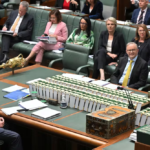Class size and academic results
Politicians and media too often discuss data about class sizes and impact on student learning without an evidence base. David Zyngier says any policy debate must start with the basic inequality of schooling.
Many policymakers and political commentators suggest that funding isn’t the problem in Australian education. They point money spent on reducing class sizes, arguing that this extra funding does not lead to better academic results.
Politicians and their advisers seem to agree, as they claim that much of Australia’s increased expenditure on education in the last 20 to 30 years has been ‘wasted’ on efforts to reduce class sizes. The class size issue also directs attention to the learning environment, while pupil/teacher ratio is typically an economic category illustrating the amount of money spent.
Most of this policy advice and commentary relies heavily on Jensen’s report (2010) on Australian education and teacher quality. Jensen suggests that the majority of studies around the world have shown that class size reductions do not significantly improve student outcomes, and that the funds should have been redirected toward enhancing teacher quality.
It is commonly assumed that class sizes in Australia are smaller than they have ever been. This is not the case. While older members of our society may recall being in classes of 40 or more students in the 1950s and early 1960s, by 1981 class sizes in Australia were generally capped at 25 in high schools and 22 in technical schools. These caps have increased since their low point in 1981, even in primary schools; while the early years in many jurisdictions are capped below 26, grades 3-6 are treated like secondary classes and capped between 28 and 30.
Reducing class size to increase student achievement is an approach that has been tried, debated, and analysed for many decades. The premise seems logical: with fewer students to teach, teachers should achieve better academic outcomes for all students. For those who choose private education for their children in Australia, it is often cited as a major consideration. The current federal minister of education is on record as declaring:
There is no evidence that smaller class sizes somehow produce better student outcomes. In spite of Australia having small class sizes for 10 years…their outcomes have gone backwards.
Moreover he confirmed that a Coalition Government would actually increase class sizes in Australian schools. A main reason for caution is that any commitment to smaller classes necessarily involves more teachers, and this has considerable resource implications for policy makers, especially under conditions of what the federal treasurer has termed a ‘budget emergency’.
In 2010 Australia’s average public primary class size (not STR) was 23.2 – above the OECD average of 21.3 and EU average of 20. This compares to 15 in Korea; 17 in Germany and the Russian Federation; 19 in Finland; 20 in the UK, Poland and Luxembourg; and 26 in India (OECD 2013). Class sizes are smaller in both the Independent and Catholic sectors in Australia.
Advocates for and against class-size reduction have engaged in or been accused of engaging in such cherry picking for as long as there has been research on this issue (Whitehurst and Chingos 2011, 3).
Policy makers, politicians and media too often discuss data about class sizes and impact on student learning without an evidence base, relying largely on second-hand research or anecdotes. Too frequently, advocates for particular positions select their evidence, conveniently ignoring research that raises questions about their favoured position.
Only two authors support the notion that smaller class sizes did not produce better outcomes to justify the expenditure. Hanushek and Hoxby seem to stand alone in their findings that class size reduction has little or no impact on student academic outcomes – yet they are disproportionately referred to for evidence here in Australia. Education researchers have refuted the work of Hanushek and Hoxby. They point out that Hanushek (and Jensen) do not examine class size directly, but rather a proxy measure intended to represent it (student-teacher ratio).
It is evident that for certain groups of children (indigenous, low SES and CLED students in the early years, and children with learning and behavioural difficulties), smaller class sizes and increased STRs are very beneficial.
Class size reduction and equity
CSR is about equity – any policy debate must start with the basic inequality of schooling, and aim to ameliorate the damage that poverty, violence, inadequate child care and other factors do to our children’s learning outcomes. It must look at the strategies, pedagogies and practices that could mediate those differences, and ‘the investments that we are willing to make as a society to put success in reach of all children’ (Graue et al. 2005, 31).
If CSR is introduced in the current policy context of high-stakes testing, together with the inadequate funding highlighted by the Gonski Review, we can expect minimal achievement outcomes. Additional resources to support class size reduction acknowledge the deep-seated inequities at the core of Australian schooling, but would not be enough.
CSR is part of a system of reforms and problems that need to be considered in a coordinated manner, in relation to both the practice and research of schooling. It necessitates implementation that ‘connects the utilisation of the resources for class size reduction with all curricular, administrative, and institutional efforts that shape teaching and learning’ (Graue et al. 2005, 32).
Recommendations for policy change
The strongest hypothesis about why small classes work concerns students’ classroom behaviour. Evidence is mounting that students in small classes are more engaged in learning activities, and exhibit less disruptive behaviour.
Schools should look at ways to produce the class size effect by lowering class size specifically for certain periods of instruction in numeracy and literacy classes. If class size could be reduced just for these lessons, using a combination of redeployment of existing staff and addition of special literacy and numeracy teachers, it would be theoretically possible to have small classes (average of 15 pupils) with a much lower additional cost. While this approach is used by some principals to deliver smaller class sizes in literacy and numeracy, it is not yet a general practice for disadvantaged groups and learners with higher needs. Targeted class size reduction combined with other proven methods of improving student achievement would be a more cost-effective means of increasing student achievement.
Differentiated staffing to reduce literacy and numeracy class size could make the cost of producing the small class effect about one-ninth greater rather than one-third greater. In contrast to across-the-board reductions that have been prevalent to date in Australia and overseas, this targeted approach is a feasible way to make class size reduction more effective and more affordable.
Writing about the USA, Haimson concludes that “many of the individuals who are driving education policy in this country … sent their own children to abundantly financed private schools where class sizes were 16 or less, and yet continue to insist that resources, equitable funding, and class size don’t matter — when all the evidence points to the contrary” (Haimson, 2009).
The same might be said of Australia.
The full paper and references can be read here.
Dr David Zyngier is Senior Lecturer in Curriculum and Pedagogy in the Faculty of Education at Monash University, having previously worked as a state school teacher and principal. His research focuses on teacher pedagogy, democratic education and Culturally, Linguistically and Economically Diverse (CLED) learning communities. David is also a member of the Editorial Board of Teaching and Teacher Education (Elsevier) and Creative Education and in 2011 was appointed Expert Commentator for the Australian Council of Education Leaders (ACEL).












